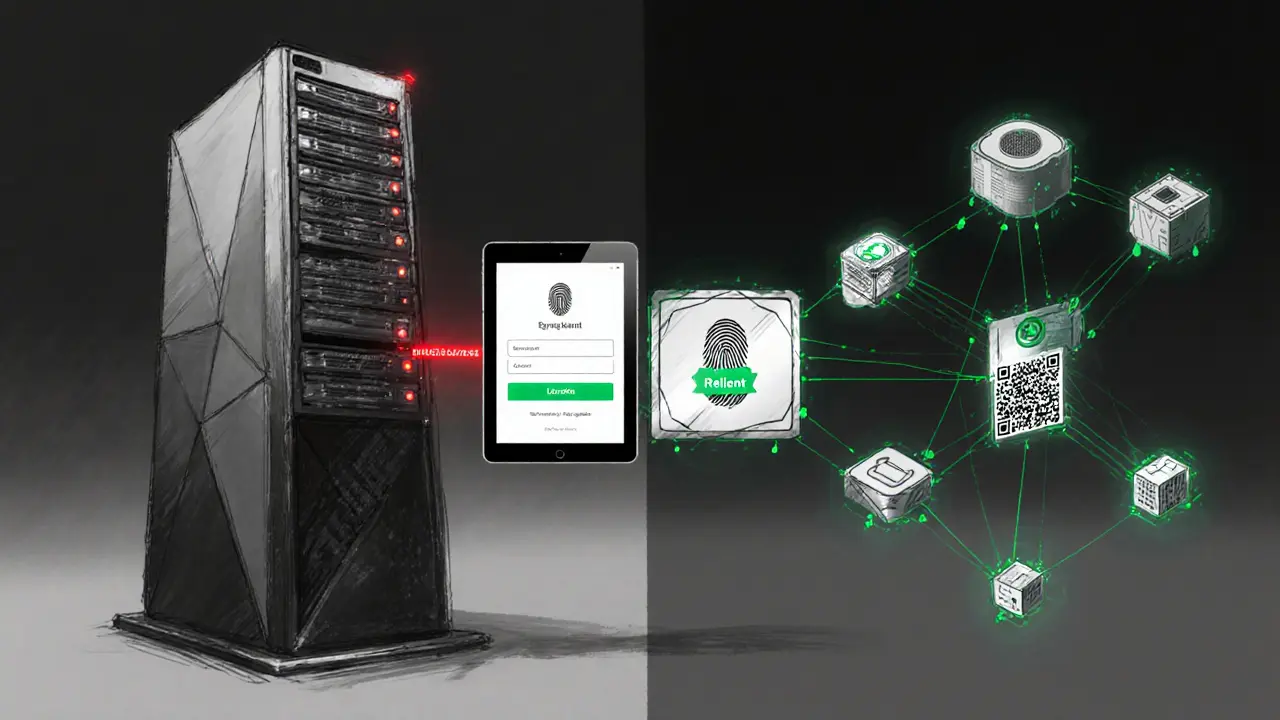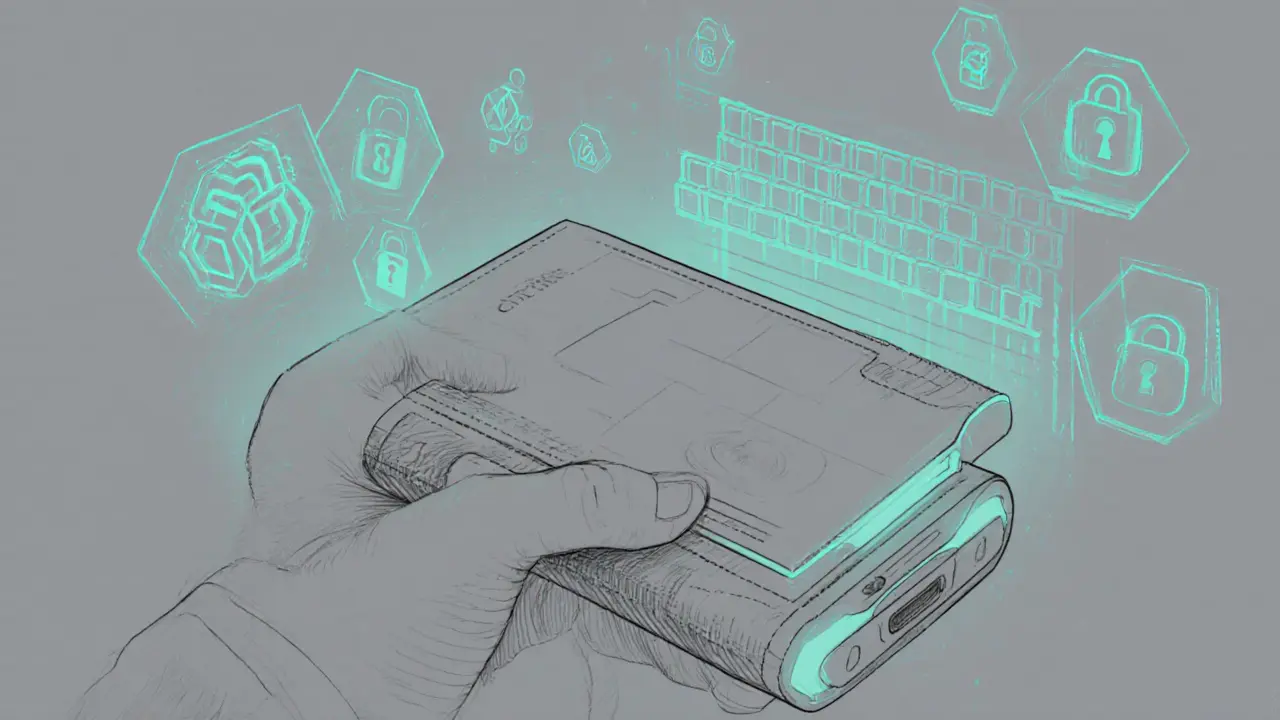DID vs Traditional Identity Comparison Tool
Toggle between traditional and decentralized identity features to compare their characteristics:
Traditional Identity Mode- Centralized Data Storage Standard
- Single Point of Failure High Risk
- User Authentication Shared Credentials
- Audit Trail Server Logs
- Credential Revocation Admin Controlled
- User-Controlled Credentials Self-Sovereign
- No Single Point of Failure Resilient
- Selective Disclosure Privacy-Focused
- Immutable Ledger Tamper-Evident
- Local Revocation User Controlled
| Feature | Traditional Identity | Decentralized Identity (DID) |
|---|---|---|
| Data Storage | Central database | User-controlled wallet; no central store |
| Single Point of Failure | Yes - breach affects all users | No - data spread across ledger + user device |
| Cryptographic Guarantees | Hashing & encryption of stored data | Public-key signatures & zero-knowledge proofs |
| Revocation | Central admin revokes access | User can revoke or expire credentials locally |
| Auditability | Log files on server | Immutable ledger entries + wallet logs |
Key Takeaways
Traditional identity systems offer simplicity and centralized control, ideal for enterprise environments. Decentralized identity provides enhanced privacy and user sovereignty, but requires more technical understanding and infrastructure investment.
When you log into a website, swipe a card, or even board a plane, somewhere your identity is being checked. Most of us assume that this happens behind the scenes in a big, central database owned by a company or government. Decentralized Identity is a completely different model - it puts the control of those credentials back in the hands of the individual, using tools like digital wallets and distributed ledgers.
Quick Take
- DIDs give users ownership of their credentials, while traditional systems keep data in central repositories.
- Security: centralized systems have single points of failure; DIDs rely on cryptographic proof and blockchain immutability.
- Privacy: DIDs enable selective disclosure, traditional models often over‑share data.
- Implementation: legacy IAM stacks are quick to deploy; DID solutions need blockchain expertise and user‑education.
- Future: hybrid approaches are emerging, but the trend favors user‑centric control.
What is a Traditional Identity System?
In a classic setup, an organization runs an Identity and Access Management (IAM) system. It collects attributes - birth date, social security number, username, password - and stores them in a central database. Protocols like OAuth and OpenID Connect (OIDC) allow that database to act as a trusted source for Single Sign‑On (SSO) across multiple apps.
Because everything lives in one place, admins can enforce policies, reset passwords, and audit access centrally. The user experience is simple: one set of credentials opens dozens of services, as long as the provider is online.
What is a Decentralized Identity (DID)?
A Digital Wallet stores cryptographic keys and verifiable credentials on the user’s device. Instead of asking a central server for your birthdate, an app sends a request to your wallet. You decide whether to reveal the exact date, an age range, or nothing at all. The proof that you own the credential is generated on‑device and verified against a Distributed Ledger - most commonly a blockchain.
Each credential is linked to a Decentralized Identifier (DID), a globally unique string that resolves to a set of public keys stored on the ledger. No single organization controls the identifier; trust is built on cryptographic proof.
Security Comparison
Centralized systems are attractive targets. The 2022 breach at ID.me, where passport data leaked due to lax internal controls, illustrates how a single compromised database can expose millions.
DID architectures avoid that risk. Because credentials never sit in a shared store, there is no “golden record” for attackers to steal. The ledger’s immutable, hash‑linked blocks make tampering practically impossible, and the user’s private keys are protected by device‑level security (PIN, biometrics, Secure Enclave).
| Feature | Traditional Identity | Decentralized Identity (DID) |
|---|---|---|
| Data Storage | Central database | User‑controlled wallet; no central store |
| Single Point of Failure | Yes - breach affects all users | No - data spread across ledger + user device |
| Cryptographic Guarantees | Hashing & encryption of stored data | Public‑key signatures & zero‑knowledge proofs |
| Revocation | Central admin revokes access | User can revoke or expire credentials locally |
| Auditability | Log files on server | Immutable ledger entries + wallet logs |

Privacy and User Control
In a traditional model, once you authenticate, the service often receives all the attributes the provider holds - even data you never asked to share. Think of a retail site pulling your full address, phone number, and birthdate just to confirm a purchase.
With DIDs, Verifiable Credentials support selective disclosure. You can prove you’re over 18 without revealing your exact birthdate, or confirm citizenship without exposing your passport number. The wallet never sends the raw data; it sends a cryptographic proof that the issuer signed a claim meeting the verifier’s policy.
This shift changes the trust model. Traditional IAM trusts a central authority to protect data; DID trusts the cryptographic chain and the issuer’s reputation. Users gain the ability to revoke a credential at any time, forcing the verifier to request fresh proof.
Operational Experience
Traditional IAM shines on ease of rollout. Companies can spin up an Active Directory instance, configure SAML or OIDC, and integrate with dozens of SaaS tools within weeks. Users enjoy a familiar login screen and don’t need to manage extra software.
DID solutions require a different mindset. Organizations must set up a ledger (public or permissioned), onboard credential issuers, and develop wallet integrations. Users need to install and secure a wallet app, understand seed phrases, and manage multiple credentials. The payoff is greater user autonomy and offline verification - a store can accept a QR‑code proof even without internet, as long as the wallet can sign locally.
Implementation Considerations
Infrastructure: Traditional systems need robust database clusters, backup, and disaster‑recovery plans. DID needs either a public blockchain (e.g., Ethereum, Hyperledger Indy) or a permissioned ledger, plus nodes to maintain consensus.
Staff expertise diverges. IAM teams are versed in LDAP, SAML, OAuth, and compliance frameworks like ISO 27001. DID projects demand blockchain developers, cryptographers, and UX designers who can make wallet onboarding painless.Regulatory compliance also differs. Centralized solutions must meet data‑residence and breach‑notification laws. DIDs can simplify GDPR compliance because personal data never leaves the user’s device unless they explicitly share it.
Adoption Trends and Future Outlook
Traditional identity federation remains dominant in education, enterprise, and government because the ecosystem is mature. However, high‑profile breaches have sparked interest in alternatives.
Since 2023, pilots in finance (digital driver’s licenses for car rentals), healthcare (patient‑controlled health records), and e‑government (e‑residency programs) have shown that DIDs can cut costs and improve privacy. The World Wide Web Consortium (W3C) continues to refine the Verifiable Credentials Data Model, making cross‑industry adoption smoother.
Looking ahead, we’ll likely see hybrid models: a central directory for low‑risk services paired with DID for high‑value transactions like banking or travel. Advances in zero‑knowledge proof standards and wallet usability are expected to lower the barrier for everyday users.
Decision Guidance: Which Approach Fits Your Needs?
Use the quick checklist below to decide:
- Speed of deployment: Need to launch in months? Traditional IAM wins.
- Data sensitivity: Handling passports, medical records, or financial data? Consider DID for stronger privacy.
- User base tech‑savviness: If your audience is comfortable with apps and security keys, DIDs add value; otherwise, stick with familiar SSO.
- Regulatory environment: If you must store data locally for compliance, a DID solution can reduce data‑ residency concerns.
- Long‑term strategy: Planning for a decentralized web? Investing early in DID infrastructure may future‑proof your stack.
In many cases, a phased approach works best: keep legacy IAM for internal apps while introducing DID for customer‑facing services that require high privacy.

Frequently Asked Questions
What exactly is a Decentralized Identifier (DID)?
A DID is a globally unique string that resolves to a set of cryptographic public keys stored on a distributed ledger. It lets a holder prove ownership of credentials without relying on a central authority.
Can traditional IAM systems be made more private?
Yes. Adding privacy‑enhancing layers like attribute‑based access control, tokenization, and Zero‑Trust networking can reduce data exposure, but the core model still involves a central store.
Do I need a blockchain to use DIDs?
Most DID methods rely on a blockchain or similar immutable ledger, but permissioned distributed ledgers (e.g., Hyperledger Fabric) can also serve the purpose without public mining.
How does revocation work with verifiable credentials?
Issuers can publish a revocation bitmap or status list on the ledger. The holder’s wallet checks that list before presenting a credential, ensuring revoked claims are rejected.
Is a digital wallet safe for everyday users?
Modern wallets use hardware‑level security (Secure Enclave, Trusted Execution Environment) and require PIN or biometric unlock. As long as users protect their seed phrase, the risk is comparable to a strong password manager.
Whether you stick with a tried‑and‑true IAM stack or venture into decentralization, the key is to match the technology to your risk profile, user expectations, and timeline. The landscape is evolving fast, so keep an eye on standards updates and real‑world pilots - they’ll give you the most reliable signals about where identity management is heading.

